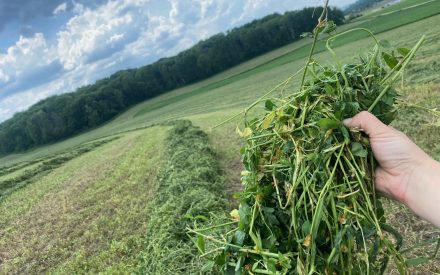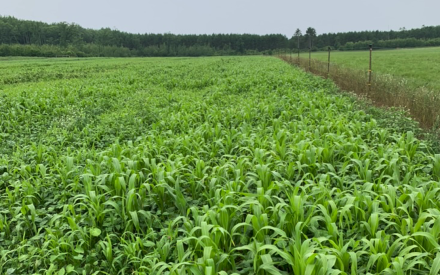What are the different types of sorghum and sudangrasses?
Sorghum and sudangrasses are warm-weather crops and will perform best in years when the growing season is characterized by higher-than-average temperatures. Cool conditions will severely limit productivity. Sorghums are diverse but generally fall into the following categories:
Grain Sorghum – also called milo, used for grain production in arid regions. This type grows 3 to 5 feet tall depending on variety and conditions. It is usually not considered for forage production because of low dry matter yield.
Forage Sorghums – includes sorgo, sweet sorghum, dual purpose (grain and forage) varieties, and hybrids. They usually grow 8 to 13 feet tall. Major use is for silage. Stems and leaves are similar in size to corn. Yields in central and southern Wisconsin have ranged from 3 tons/A in cool years to 11 tons/A dry matter in years with above average temperatures. Feeding value of sorghum silage is 80-90% that of comparable corn silage. Some long season and/or non-flowering types will need to be killed by frost to dry down enough for ensiling.
Sudangrass – grows from 4 to 7 feet tall, has leaves about 1⁄2 inch wide and stems about 1⁄4 inch in diameter. It can be harvested as pasture, green chop, hay, or silage. Yields have ranged from 3 to 5 tons/A dry matter. It can be ready for harvest as early as 45 days after planting. The smaller stems give it better drying characteristics than other sorghums for hay making. Sudangrass hybrids are available that are slightly larger and higher yielding.
Sorghum-sudangrass Hybrids – are intermediate in plant size between sorghum and sudangrass. Yield is generally less than that for forage sorghums but similar or slightly higher than sudangrass. It can be used for hay, haylage, green-chop, and pasture. Larger stems make drying for hay more difficult than for sudangrasses.
When and how should sorghums and sudangrasses be seeded?
Sorghums and sudangrasses should be seeded after the soil temperature has reached 60 to 65°F. This is normally 3 weeks after corn planting (May 20th in southern WI to June 1st in central WI). Sorghum can be established either by conventional or reduced tillage methods. Soil pH should be between 6 and 7.5 with 6.5 being considered optimum. Recommended seeding depth for all sorghums is 3⁄4 to 11⁄4 inches in heavy soils and up to 2 inches in sands. Seed at the rate of 12-15 lbs/A. Sorghums are normally seeded with a corn planter using 20 to 30-inch row spacing. Sudangrass is usually seeded with a grain drill at 20 to 30 lbs/A using 6 to 7-inch row spacing. Sorghum-sudangrass hybrids can be seeded either way at 20 to 30 lbs/A, depending on intended use (hay or silage).
What is the concern about prussic acid poisoning?
Sorghum and sudangrass plants contain a compound called dhurrin, which can break down to release prussic acid (hydrogen cyanide, HCN). Sudangrass has low levels of this compound and rarely kills animals. Sorghum has the highest levels and sorghum-sudangrasses are intermediate. There is also considerable varietal difference in prussic acid content for all types of sorghums.
Dhurrin content is highest in young plants. Therefore, the recommendation is not to graze or cut for green chop until the plant is 18 to 20 inches tall. This also applies to young regrowth in pastures. After a drought, new shoots may appear and the grazing cattle will switch from the taller forage to the new tender shoots. In addition, do not graze or green chop for 10 days after a killing frost.
High levels of nitrogen fertilizer or manure will increase the likelihood of prussic acid poisoning as well as nitrate poisoning. Very dark green plant growth often contains higher levels of prussic acid.
Most prussic acid is lost during the curing process. Therefore, hay and silage are seldom toxic even if the original forage was. Do not leave green chop in a wagon overnight and then feed. The heat that occurs will release prussic acid and increase likelihood of toxicity in the feed.
Individual animals vary in susceptibility to prussic acid poisoning. Cattle are more susceptible than sheep. Animals receiving grain with the sorghum forage are less likely to be affected.
When should sorghums and sudangrasses be harvested?
Silage – Forage sorghums should be harvested at the mid dough stage for ensiling. At this point, quality is still good and most types have dried down enough for ensiling. Non-heading types usually require a killing frost for the plant to get dry enough to ensile. This can be a problem in that lodging and leaf loss (therefore quality) may occur during the drying period after frost.
Hay – Highest yields are obtained when sudangrass and sorghum-sudangrass hybrids are harvested at the soft-dough stage (if a heading type). However, curing is difficult and quality is low when harvested this late. The general recommendation is to harvest either type for hay whenever forage is about 30 inches high. Sorghum-sudangrass hybrids are generally more difficult to make hay out of because of the larger stems. Crop should be cut six inches above the ground to encourage regrowth and two cuttings may be expected depending on yield
Green chop – Sudangrass and sorghum-sudangrass hybrids can be used to provide green chopped forage over summer. Begin chopping after the plant is 18 inches tall or cut at least 10 days after a killing frost to avoid prussic acid concerns. First cutting should be taken prior to heading.
Pasture – Sudangrass or sudangrass hybrids can be grazed any time after the plant has reached a height of 18 inches, which is usually 5 to 6 weeks after planting. For best results, it should be grazed rotationally with a sufficiently heavy stocking rate to remove forage down to a 6 to 8 inch height in a few days. The pasture will grow rapidly when the cattle are removed for more total tonnage. Additionally, if the grazing period is short, cattle will be less likely to be grazing regrowth that is high in prussic acid.
What is the feeding value of sorghums and sudangrasses?
Although these forages are generally similar to corn silage in feed value for beef cattle and sheep, there are some differences. Sudangrass grazed in its early vegetative stage contains as much available energy as corn silage and considerably more protein. However, mature sudangrasses and most sorghum and sudangrass silages are 15-20% lower in available energy than corn silage. This is because of the lower grain-to-forage ratios of the sorghums, and also because the seed coat is harder than corn and far more grain passes undigested through the animal. Crude protein levels are similar to corn silage, but they are rather variable and depend in part on the amount of nitrogen fertilization.
There are brown midrib forage sorghums, sorghum- sudangrass hybrids and sudangrasses. We would recommend using brown midrib types of any of these forages. These types have not had the extent of yield reduction associated with brown midrib in corn silage. Standability is not an issue with the brown midrib sorghum- sudangrass hybrids or the brown midrib sudangrasses. Research at Nebraska showed 13% more milk production from brown midrib forage sorghums than standard forage sorghums. Additional research in Indiana has shown benefit of brown midrib sorghum-sudangrass hybrids in beef rations.
Calcium and phosphorus levels of forage sorghums and sudangrasses are somewhat higher than corn silage, and the calcium-phosphorus ratio is better. Sorghum and sudangrass contain relatively high levels of potassium. Sheep producers should be aware that these forages evidently accumulate copper more than corn and often show copper levels of more than 30 ppm. This is usually not a problem for cattle, but sheep grazing or being fed sorghum and sudangrass forage should have access to a mineral mixture containing molybdenum and no additional copper.

 Summer Annual Forages: Diversify your feed
Summer Annual Forages: Diversify your feed ▶ Watch: Focus on Forage Cover Crops
▶ Watch: Focus on Forage Cover Crops Growing successful late-summer and spring planted forage crops
Growing successful late-summer and spring planted forage crops Prussic acid and nitrate toxicity in sorghums
Prussic acid and nitrate toxicity in sorghums


